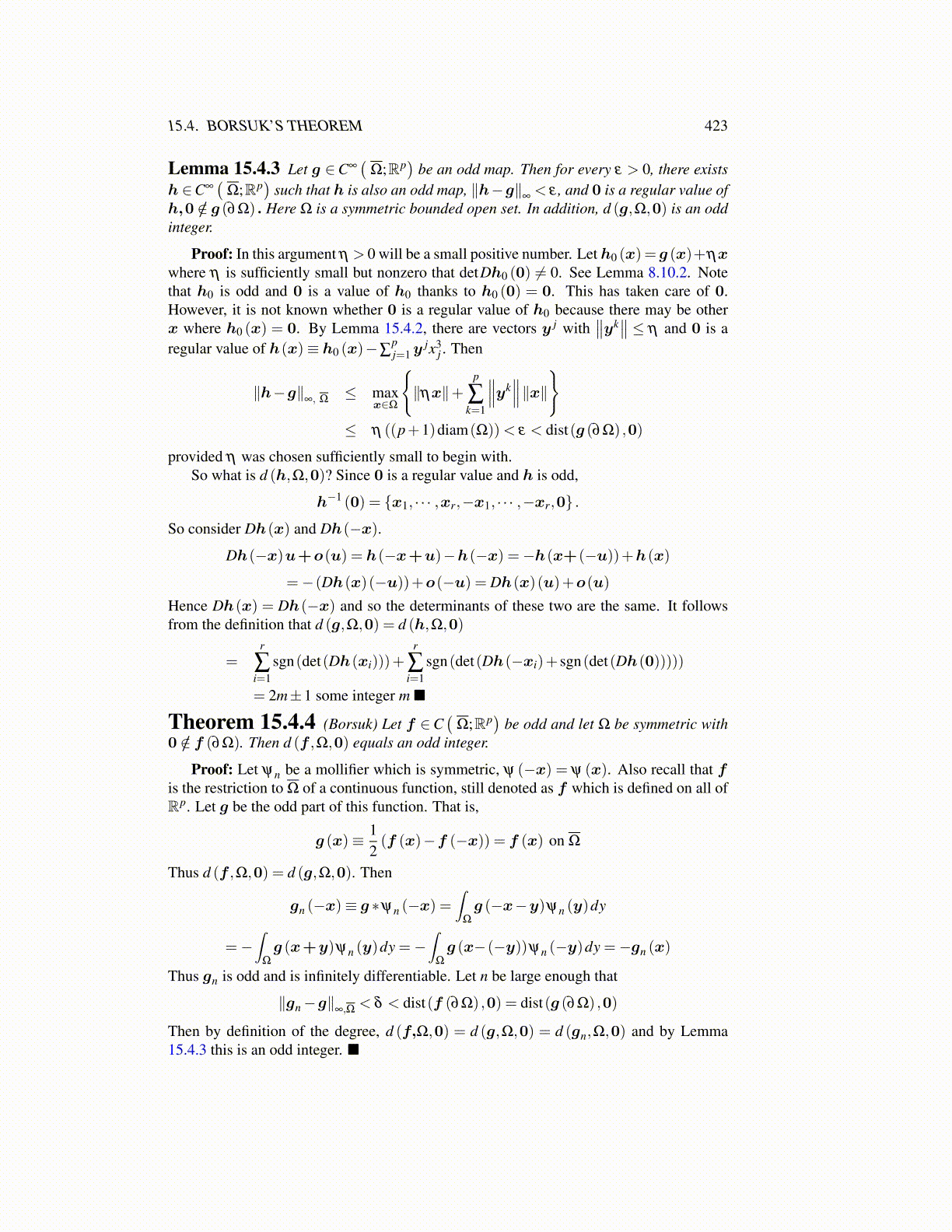
15.4. BORSUK’S THEOREM 423
Lemma 15.4.3 Let g ∈C∞(
Ω;Rp)
be an odd map. Then for every ε > 0, there existsh ∈C∞
(Ω;Rp
)such that h is also an odd map, ∥h−g∥
∞< ε , and 0 is a regular value of
h,0 /∈ g (∂Ω) . Here Ω is a symmetric bounded open set. In addition, d (g,Ω,0) is an oddinteger.
Proof: In this argument η > 0 will be a small positive number. Let h0 (x) = g (x)+ηxwhere η is sufficiently small but nonzero that detDh0 (0) ̸= 0. See Lemma 8.10.2. Notethat h0 is odd and 0 is a value of h0 thanks to h0 (0) = 0. This has taken care of 0.However, it is not known whether 0 is a regular value of h0 because there may be otherx where h0 (x) = 0. By Lemma 15.4.2, there are vectors y j with
∥∥yk∥∥ ≤ η and 0 is a
regular value of h(x)≡ h0 (x)−∑pj=1y
jx3j . Then
∥h−g∥∞, Ω
≤ maxx∈Ω
{∥ηx∥+
p
∑k=1
∥∥∥yk∥∥∥∥x∥}
≤ η ((p+1)diam(Ω))< ε < dist(g (∂Ω) ,0)
provided η was chosen sufficiently small to begin with.So what is d (h,Ω,0)? Since 0 is a regular value and h is odd,
h−1 (0) = {x1, · · · ,xr,−x1, · · · ,−xr,0} .
So consider Dh(x) and Dh(−x).
Dh(−x)u+o(u) = h(−x+u)−h(−x) =−h(x+(−u))+h(x)
=−(Dh(x)(−u))+o(−u) = Dh(x)(u)+o(u)
Hence Dh(x) = Dh(−x) and so the determinants of these two are the same. It followsfrom the definition that d (g,Ω,0) = d (h,Ω,0)
=r
∑i=1
sgn(det(Dh(xi)))+r
∑i=1
sgn(det(Dh(−xi)+ sgn(det(Dh(0)))))
= 2m±1 some integer m ■
Theorem 15.4.4 (Borsuk) Let f ∈C(
Ω;Rp)
be odd and let Ω be symmetric with0 /∈ f (∂Ω). Then d (f ,Ω,0) equals an odd integer.
Proof: Let ψn be a mollifier which is symmetric, ψ (−x) = ψ (x). Also recall that fis the restriction to Ω of a continuous function, still denoted as f which is defined on all ofRp. Let g be the odd part of this function. That is,
g (x)≡ 12(f (x)−f (−x)) = f (x) on Ω
Thus d (f ,Ω,0) = d (g,Ω,0). Then
gn (−x)≡ g ∗ψn (−x) =∫
Ω
g (−x−y)ψn (y)dy
=−∫
Ω
g (x+y)ψn (y)dy =−∫
Ω
g (x−(−y))ψn (−y)dy =−gn (x)
Thus gn is odd and is infinitely differentiable. Let n be large enough that
∥gn−g∥∞,Ω < δ < dist(f (∂Ω) ,0) = dist(g (∂Ω) ,0)
Then by definition of the degree, d (f,Ω,0) = d (g,Ω,0) = d (gn,Ω,0) and by Lemma15.4.3 this is an odd integer. ■